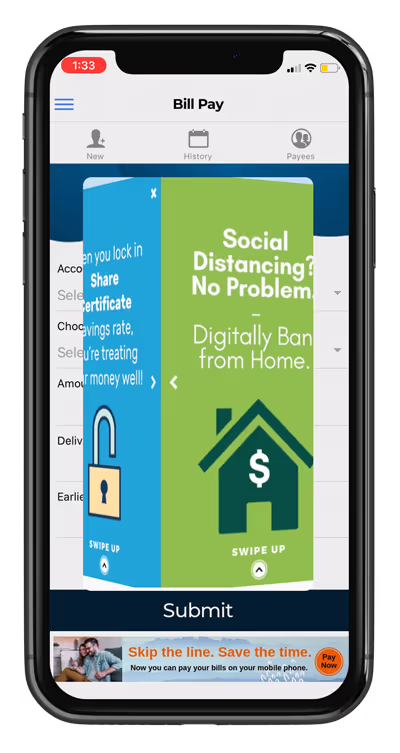Traditional Marketing for FIs (#1-3)
There is a myriad of options when it comes to traditional avenues of advertising your financial institution.
From classic billboards to corporate event sponsorships, here are some tried-and-true ways of getting the word out for your brand.
1) Local TV, Radio, Billboards
Financial institutions can reach their local audience via TV, radio, and billboards by focusing on a defined geographical region. While some may consider these methods archaic, they still can carry weight and bring in customers for your bank or credit union!
2) Sponsoring Community Events
Community is incredibly important for financial institutions that rely on their reputation to gain trust amongst existing and prospective customers. One way to create a positive brand image is to engage with the community while sponsoring in-person events. To do this, it is useful to get insights and feedback from key customers who also happen to be community leaders or advocates.
3) Partnering with Local Businesses
Joining efforts with a trusted, local company who has the same values as the financial institution’s customers/members lends to a wider reach of consumers within the community. For a financial institution, co-branding and partnering with other local businesses also promotes the FI’s commitment to small, local businesses, thus giving them a better standing in their community.
Digital Marketing for FIs (#4-8)
Successful digital marketing campaigns can effectively reach account holders, resulting in lead generation and cross-sales.
The key benefits of digital marketing vs. traditional marketing are:
- More precisely defined audiences
- Accessibility of data to build customer personas
- Effective way to reach younger generations
- Improved marketing cost-efficiency
- Greater budget flexibility
- Easier A/B testing (Source: Banks.com)
4) Email Marketing
The key to a successful email marketing strategy is to provide quality over quantity when it comes to communication. Financial institutions can provide relevant and valuable content that serves customers and members on their financial journey by using data insights about them.
Customer or member data gathered from website engagement and internal information can be used to generate relevant content and offers that go beyond marketing to dually serve as good customer service!
5) SMS Text Ads
SMS messaging offers engaging content in a format that most smartphone users are highly familiar with and inclined to respond to quickly. With open and response rates far above any other channel, text messaging can be used as a value-added tool to inform customers or members of new services or offerings. SMS is a marketing strategy that builds engagement with customers across their financial journey!
6) Display and Retargeted Ads
The financial industry has been adopting digital campaigns that use images, video, text, and hyperlinks where users can learn more about a product or service. When these display ads use consumer data insights and AI to serve up highly relevant content within authenticated apps (such as online banking and mobile banking), they capture attention and have proven to yield excellent results.
Progressive marketing techniques also apply the practice of retargeting, which serves the message to a group of users who have previously visited the site. By retargeting these users, financial institutions can stay on the top of the users’ minds and bring them back to the site to learn more.
7) Active Social Media Posting
Social media is the golden standard of online engagement and has been since the launch of the first social networking website close to two decades ago! Social media should not be used merely to sell, but it should be utilized to grow connections and foster relationships. It can be used to build relationships with customers and is becoming a fundamental part of financial institutions’ marketing mix and branding strategies. Social media is also an ideal medium to receive feedback and to adjust messaging or tactics.
Additionally, social media is emerging as a cost-effective approach to providing customer service. By using social media to deliver customer service, financial institutions report cost savings of more than 70% in comparison with the traditional phone call approach to customer service. (Source: FinTech Futures)
8) Personalized, In-App Ads
Creating targeted, personal communication across all channels builds conviction and loyalty between the consumer and their bank or credit union. Automation and intelligence can help power these communications at scale. Meaningful messages compel user engagement by relaying content that interests them. Highly targeted, personalized messaging leads to exceptional results!
The use of personalization brings together both logical and emotional factors in creating messaging that is catered to each user. This facilitates tailored experiences while building stronger relationships and loyalty, all while making marketing efforts more efficient and cost-effective. (Source: Marketing Evolution)

Digital Banking is Crucial in Today's Financial Landscape
Over the past decade, financial institutions have made significant investments in technology, with digital banking apps being at the forefront of modern banking. Digital banking is fast emerging as the primary gateway for customers to transact with their banks. The priority and investment here have brought many benefits to banking consumers as their many transactions became virtual!







